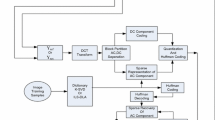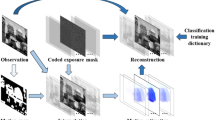Abstract
For compressed sensing (CS) recovery, the reconstruction quality is highly dependent on the sparsity level of the representation for the signal. Motivated by the observation that the temporal residual image is much sparser than its original image, a temporal residual-domain dictionary learning method for CS video recovery is proposed in this paper. The adaptive basis is learned from inter-frame differences by Karhunen–Loeve transform (KLT) to represent the residuals. And a block-based motion estimation/motion compensation (ME/MC) residual reconstruction strategy is incorporated for the CS video recovery. Experimental results on common test sequences at various sampling rates illustrate that the proposed algorithm gains great improvements over existing approaches. For some video sequences, the proposed method outperforms the state-of-art method near 1 dB in terms of peak signal noise rate (PSNR) at some higher sampling rate.


Similar content being viewed by others
References
Aharon M, Elad M, Bruckstein A (2006) K-SVD: an algorithm for designing overcomplete dictionaries for sparse representation. IEEE Trans Sign Proc 54(11):4311–4322
Bertero M, Boccacci P (1998) Introduction to inverse problems in imaging. Institute of Physics Publishing, Bristol
Bredies K, Kunisch K, Pock T (2010) Total generalized variation. SIAM J Imag Sci 3(3):492–526
Candes EJ, Romberg J, Tao T (2006) Stable signal recovery from incomplete and inaccurate measurements. Commun Pure Appl Math 59(8):1207–1223
Candes EJ, Wakin MB (2008) An introduction to compressive sampling. IEEE Signal Process Mag 25(2):21–30
Duarte MF, Davenport MA, Takhar D (2008) Single-pixel imaging via compressive sampling. IEEE Signal Process Mag 25(24):83–91
Eslahi N, Aghagolzadeh A, Andargoli SMH (2015) “Compressive video sensing via dictionary learning and forward prediction.” arXiv, preprint arXiv:1508.07640
Gan L (2007) “Block compressed sensing of natural images”. Proc Int Conf Digit Sign Process, Cardiff, UK 403–406
Goldstein T, Osher S (2009) The split Bregman algorithm for L1 regularized problems. SIAM J Imag Sci 2:323–343
Kang LW, Lu CS (2009) “Distributed compressive video sensing,”. Proc Int Conf Acoustics, Speech, Sign Process (ICASSP) 1169–1172, Taipei, Taiwan
Kwon S, Wang J, Shim B (2014) Multipath matching pursuit. IEEE Trans Inform Theory 50(5):2986–3001
Liu Y, Li M, Pados DA (2013) Motion-aware decoding of compressed-sensed video. IEEE Trans Circ Syst Video Technol 23(3):438–444
Liu Q, Wang SS, Ying LL (2013) Adaptive dictionary learning in sparse gradient domain for image recovery. IEEE Trans Image Proc 22(12):4652–4663
Mun S, Fowler JE (2011) “Residual reconstruction for block-based compressed sensing of video”. Proc Data Compress Conf 183–192, Snowbird, UT
Ophir B, Lustig M, Elad M (2011) Multi-scale dictionary learning using wavelets. IEEE J Sel Topics Sign Process 5(5):1014–1024
Ravishankar S, Bresler Y (2011) MR image reconstruction from highly undersampled k-space data bydictionary learning. IEEE Trans Med Imaging 30(5):1028–1041
Stankovic V, Stankovic L, Cheng S (2008) “Compressive video sampling,”. Proc Eur Signal Proc Conf (EUSIPCO)
Wakin MB, Laska JN, Duarte MF (2006) “Compressive imaging for video representation and coding”. Proc Picture Coding Symp (PCS) 711–716
Yue H, Ongie G, Ramani S, Jacob M (2013) Generalized higher degree total variation (HDTV) regularization. IEEE Trans Image Proc 23(6):2423–2435
Zhang J, Zhao C, Zhao D, Gao W (2014) Image compressive sensing recovery using adaptively learned sparsifying basis via L0 minimization. Signal Process 103:114–126
Zhao YB (2013) RSP-based analysis for sparsest and least ℓ1-norm solutions to underdetermined linear systems. IEEE Trans Signal Proc 61(22):5777–5788
Acknowledgments
This work was supported in part by the Hunan Province Science and Technology Planning Project (nos. 2014FJ6047 and 2014GK3030), the Science Research Key Project of the Education Department of Hunan Province (nos. 13A107 and 15A007), and the Changsha Science and Technology Planning Project (no. K1403028-11).
Author information
Authors and Affiliations
Corresponding author
Rights and permissions
About this article
Cite this article
Song, Y., Yang, G., Xie, H. et al. Residual domain dictionary learning for compressed sensing video recovery. Multimed Tools Appl 76, 10083–10096 (2017). https://doi.org/10.1007/s11042-016-3599-4
Received:
Revised:
Accepted:
Published:
Issue Date:
DOI: https://doi.org/10.1007/s11042-016-3599-4




